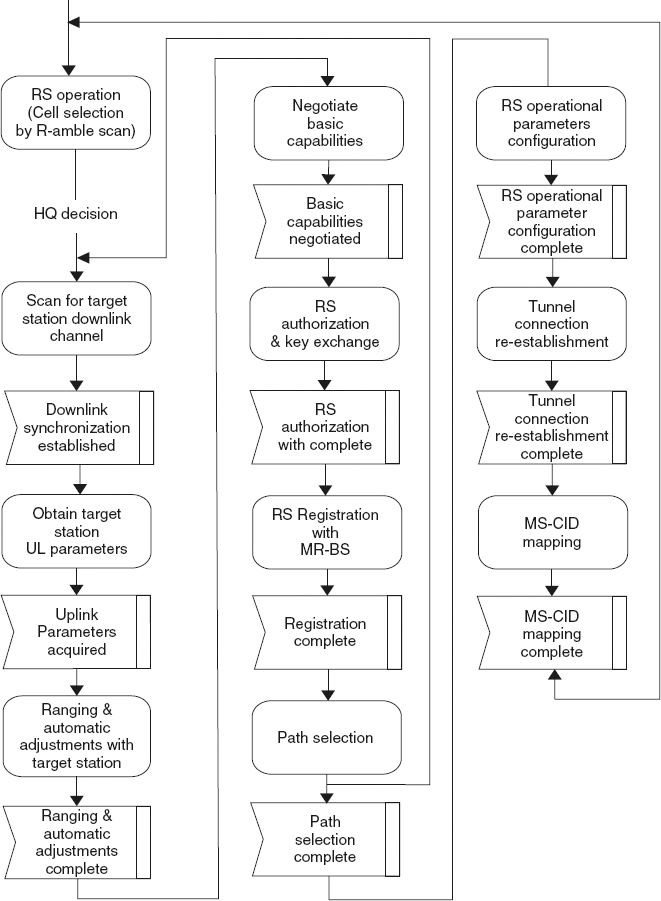Mobility Management in IEEE 802.16j-2009
The IEEE 802.16j amendment describes how the MR-BSs and the RSs should behave during MS mobility between MR-BSs and RSs, and between different RS. The amendment also details the signaling required for RS mobility. In both cases, the MR-BS maintains substantial control of MS handover, even when scheduling ntRSs are involved.
MR-BS and RS Behavior during MS Handover
Depending on the type of the MS's target superordinate station, the MR-BS ensures sufficient resources are provided so that signaling between the MR-BS and the MS can be delivered. If the superordinate is an ntRS with centralized scheduling, MR-BS inserts a Fast Ranging IE in the UL-MAP to be broadcast on the access link and provides sufficient bandwidth on the relay link for forwarding the RNG-REQ. If the superordinate station is a scheduling ntRS, it is instructed by the MR-BS to send the Fast Ranging IE. For tRSs, the MR-BS inserts the Fast Ranging IE in the UL-MAP and provides sufficient bandwidth in the tRS's uplink; the tRS, in turn, would forward the RNG-REQ on the access link.
For topology advertisement, each ntRS may advertise differently from the MR-BS's own MOB_NBR-ADV. Under centralized scheduling, the MR-BS must allocate bandwidth for its advertisement; under distributed scheduling, the RSs are autonomous in their allocation.
MR-BS controls the scanning procedure. Scheduling ntRSs coordinate with MR-BS to schedule scanning, and may terminate scanning procedures if they see fit. For ntRS with unique BSIDs and centralized scheduling, RSs not involved in the handover are notified to ignore handover communication. This applies to RSs within and outside the MR-cell. Scheduling ntRS act similarly but notify the MR-BS of the association. An MR-BS in turn, confirms the association if it sees fit. When an MS perform neighbor scanning Level 0 or Level 1, access stations perform the same tasks as those for contention based initial ranging. RSs may report the observed link quality to the MR-BS. This applies for both tRS and ntRS. Neighboring ntRSs shall inform the MR-BS through a RNG-RSP.
An MS handover requires updating the routing information. A serving MR-BS sends out an MS_INFO-Del to old RS when the latter is no longer supposed to maintain the MS's information. The RS must confirm deletion. Similarly, when a target cell is informed that the MS has attached to a different RS or MR-BS, that is, a drop has occurred, it notifies the old station to delete the MS's context.
For handover optimization, context transfer can be made either by the serving or the target access station. In either case, if the requesting station is an RS, it shall not include information about its respective MR-BS; rather, the MR-BS will augment its own information to the context message.
Mobile RS Handover
When a mobile RS (MRS) is handed over from one access station to the other, it follows procedures similar to those of a regular MS. As depicted in Figure 7.2, however, additional steps are required in order to maintain connectivity for both the MRS and the MSs it oversees.
These additional steps are:
- Access station selection;
- MRS operational parameters configuration;
- Tunnel connection re-establishment; and
- MS CID mapping.
Steps 1–3 can each be skipped in a handover optimization while the last step, which is required for the RS to map the CIDs of the MSs it oversees, is not required for tunnel based forwarding.
An MRS handover can be initiated either by the MRS (through a MOB_MSHO-REQ) or the serving MR-BS (through a MOB_BSHO-REQ). If the MRS is switching MR-cells, the serving MR-BS may send the MRS's MAC address, in addition to the context of the MSs attached, to the target MR-BS. A target MR-BS may assign new CIDs or tunnel CIDs to the attached MSs; in this case, the MR-BS would inform the MRS through a RNG-RSP message of the old and new CID pairs so that the MRS would update its records and its forwarding.
The procedure described above does not involve a preamble change. The target MR-BS may decide that the MRS's preamble will change after handover. In this case, the target MR-BS sends the serving MR-BS a preamble index that is forwarded to the MRS, including a frequency adjustment if required. The MRS would inform MSs attached to it of changes in channel characteristics through a MOB_NBR-ADV message that includes itself. Prior to the MRS handover, the serving MR-BS would have exchanged handover decisions and initiations with the MSs attached to the MRS.

Figure 7.2 Flowchart for the mobile relay station handover process. Reproduced by permission of © 2009 IEEE.
For mobility within an MR-cell, an MR-BS may decide to change the preamble index of an MRS due to collisions in preamble index or to mitigate interference. In such instances, the MRS would undergo a preamble index change process, and the attached MSs would be handed off from the MRS to itself using regular MS handover procedures.
If an MRS detects its drop during a handover, it will try to reconnect to its serving BS through cancelling the handover if still possible. If not, it attempts to reconnect with its preferred target MR-BS through reselection. If reselection fails, the MRS performs initial network entry procedure. In doing so, the MRS uses a HO code in its CDMA ranging. This enables the target MR-BS to recognize that the MRS's handover was not successful, and it may request the MRS's context (the MRS's and the attached MSs') from the serving MR-BS.
